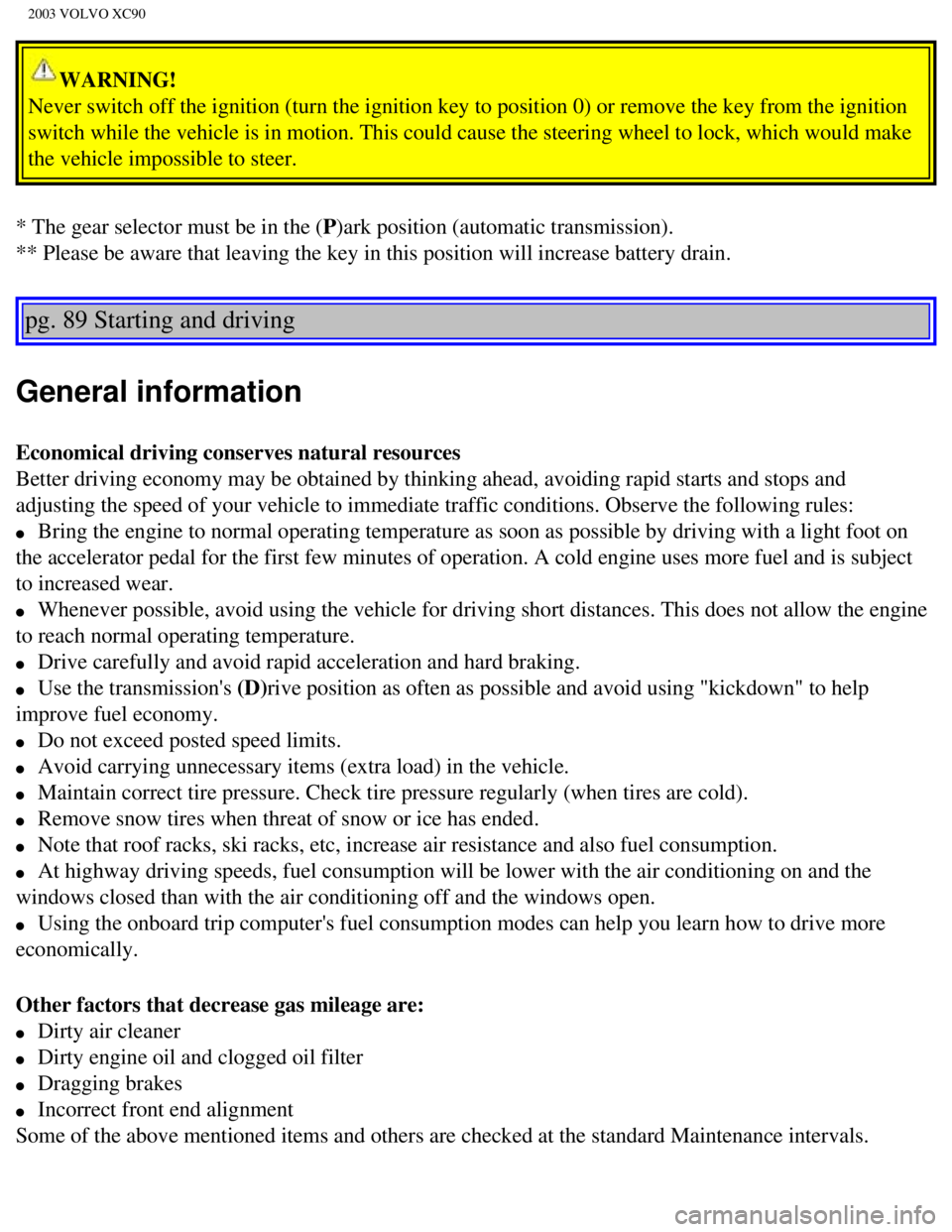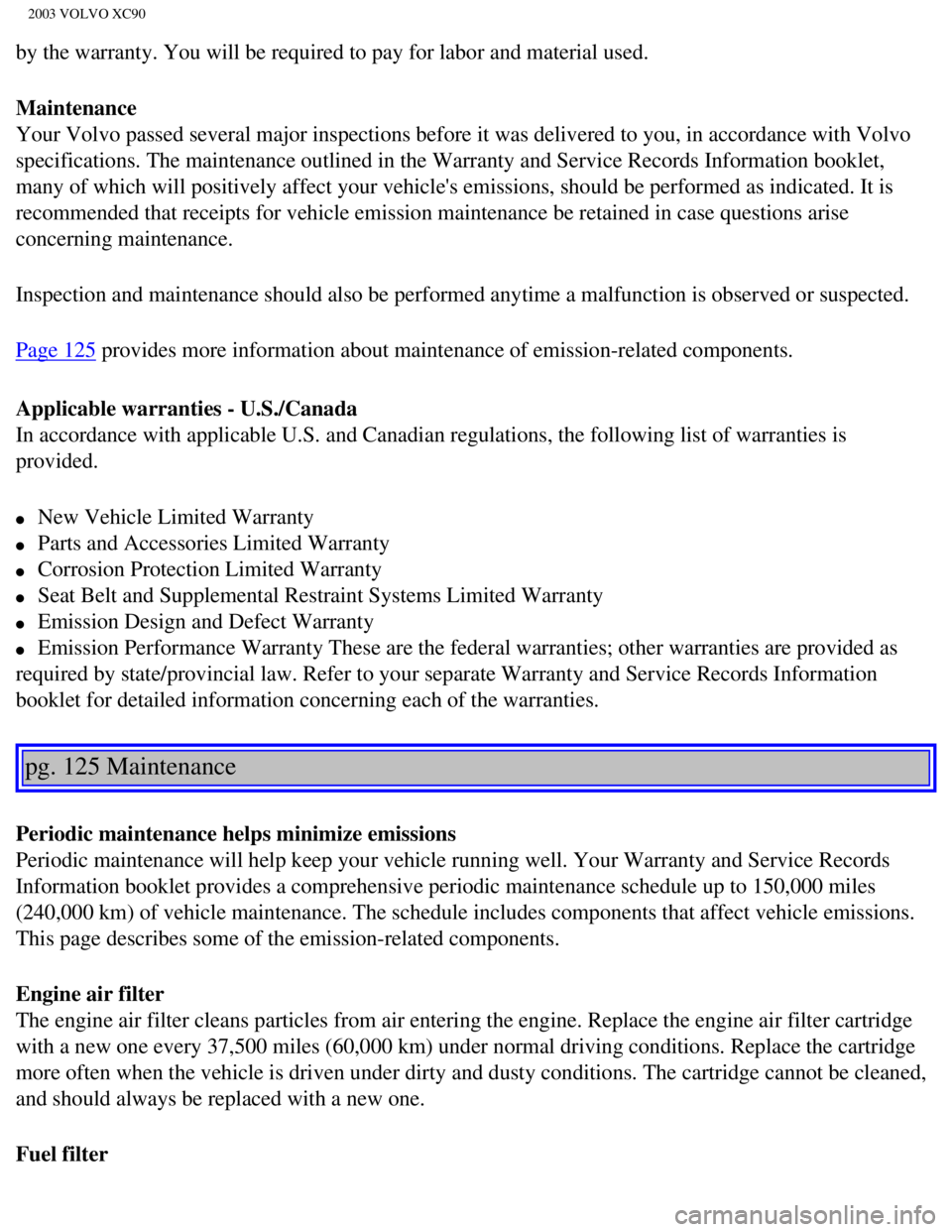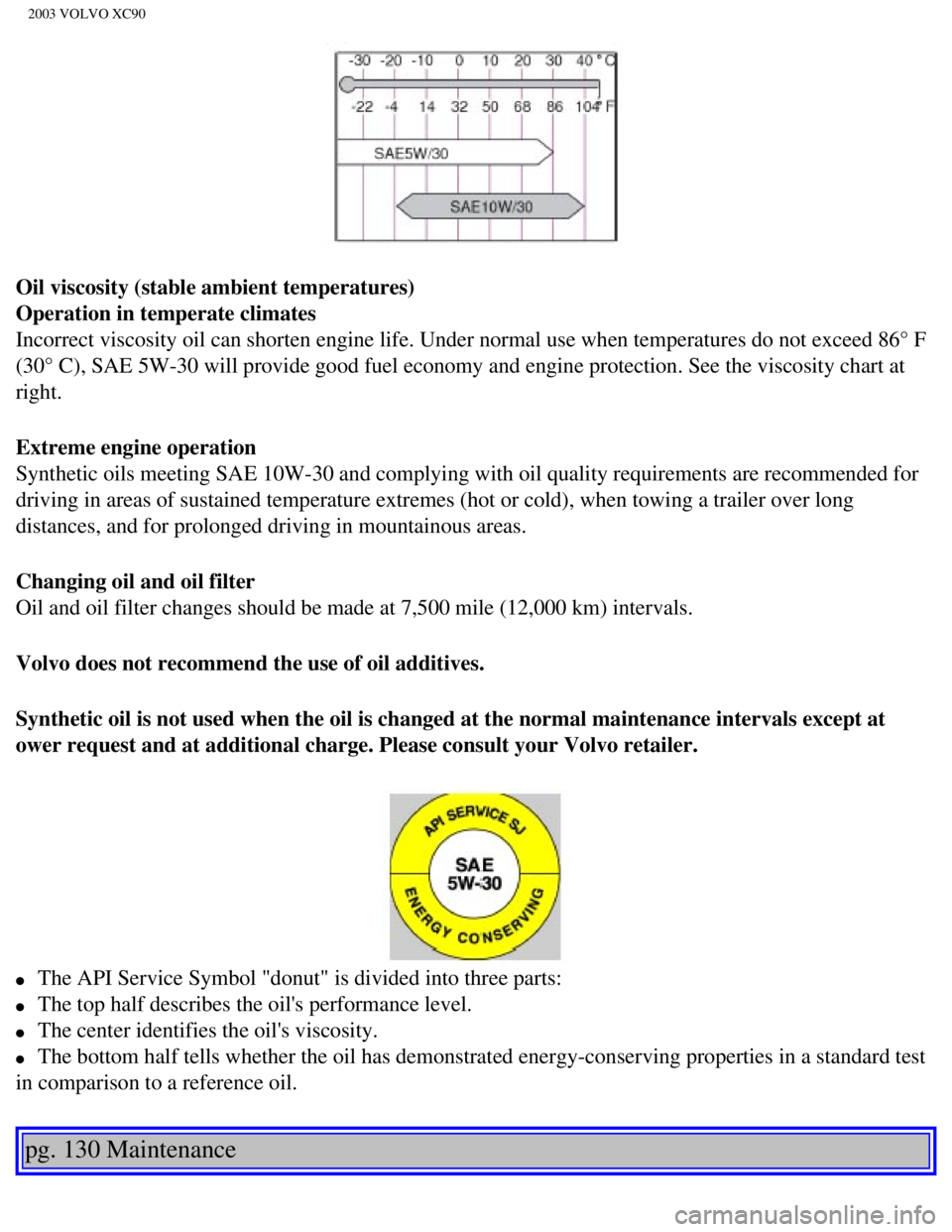2003 VOLVO XC90 fuel filter
[x] Cancel search: fuel filterPage 111 of 242

2003 VOLVO XC90
WARNING!
Never switch off the ignition (turn the ignition key to position 0) or\
remove the key from the ignition
switch while the vehicle is in motion. This could cause the steering whe\
el to lock, which would make
the vehicle impossible to steer.
* The gear selector must be in the (P)ark position (automatic transmission).
** Please be aware that leaving the key in this position will increase b\
attery drain.
pg. 89 Starting and driving
General information
Economical driving conserves natural resources
Better driving economy may be obtained by thinking ahead, avoiding rapid\
starts and stops and
adjusting the speed of your vehicle to immediate traffic conditions. Obs\
erve the following rules:
l Bring the engine to normal operating temperature as soon as possible by \
driving with a light foot on
the accelerator pedal for the first few minutes of operation. A cold eng\
ine uses more fuel and is subject
to increased wear.
l Whenever possible, avoid using the vehicle for driving short distances. \
This does not allow the engine
to reach normal operating temperature.
l Drive carefully and avoid rapid acceleration and hard braking.
l Use the transmission's (D)rive position as often as possible and avoid using "kickdown" to help
improve fuel economy.
l Do not exceed posted speed limits.
l Avoid carrying unnecessary items (extra load) in the vehicle.
l Maintain correct tire pressure. Check tire pressure regularly (when tir\
es are cold).
l Remove snow tires when threat of snow or ice has ended.
l Note that roof racks, ski racks, etc, increase air resistance and also f\
uel consumption.
l At highway driving speeds, fuel consumption will be lower with the air c\
onditioning on and the
windows closed than with the air conditioning off and the windows open. \
l Using the onboard trip computer's fuel consumption modes can help you le\
arn how to drive more
economically.
Other factors that decrease gas mileage are:
l Dirty air cleaner
l Dirty engine oil and clogged oil filter
l Dragging brakes
l Incorrect front end alignment
Some of the above mentioned items and others are checked at the standard\
Maintenance intervals.
file:///K|/ownersdocs/2003/2003_XC90/03xc90_06a.htm (8 of 15)12/30/200\
6 4:18:58 PM
Page 154 of 242

2003 VOLVO XC90
by the warranty. You will be required to pay for labor and material used\
.
Maintenance
Your Volvo passed several major inspections before it was delivered to y\
ou, in accordance with Volvo
specifications. The maintenance outlined in the Warranty and Service Rec\
ords Information booklet,
many of which will positively affect your vehicle's emissions, should be\
performed as indicated. It is
recommended that receipts for vehicle emission maintenance be retained i\
n case questions arise
concerning maintenance.
Inspection and maintenance should also be performed anytime a malfunctio\
n is observed or suspected.
Page 125 provides more information about maintenance of emission-related compone\
nts.
Applicable warranties - U.S./Canada
In accordance with applicable U.S. and Canadian regulations, the followi\
ng list of warranties is
provided.
l New Vehicle Limited Warranty
l Parts and Accessories Limited Warranty
l Corrosion Protection Limited Warranty
l Seat Belt and Supplemental Restraint Systems Limited Warranty
l Emission Design and Defect Warranty
l Emission Performance Warranty These are the federal warranties; other wa\
rranties are provided as
required by state/provincial law. Refer to your separate Warranty and Se\
rvice Records Information
booklet for detailed information concerning each of the warranties.
pg. 125 Maintenance
Periodic maintenance helps minimize emissions
Periodic maintenance will help keep your vehicle running well. Your Warr\
anty and Service Records
Information booklet provides a comprehensive periodic maintenance schedu\
le up to 150,000 miles
(240,000 km) of vehicle maintenance. The schedule includes components \
that affect vehicle emissions.
This page describes some of the emission-related components.
Engine air filter
The engine air filter cleans particles from air entering the engine. Rep\
lace the engine air filter cartridge
with a new one every 37,500 miles (60,000 km) under normal driving con\
ditions. Replace the cartridge
more often when the vehicle is driven under dirty and dusty conditions. \
The cartridge cannot be cleaned,
and should always be replaced with a new one.
Fuel filter
file:///K|/ownersdocs/2003/2003_XC90/03xc90_09a.htm (2 of 15)12/30/200\
6 4:19:02 PM
Page 155 of 242

2003 VOLVO XC90
The fuel filter should be replaced at 120,000 miles (193,000 km). The \
filter is replaced as a complete
unit. Replace more frequently if contaminated fuel is introduced into th\
e tank, or if there is reason to
suspect that this has occurred.
Fuel system, including filler cap, tank, lines, and connections
The ability of the fuel system to contain hydrocarbons depends upon a le\
ak-free system. Inspect fuel
lines every 30,000 miles (48,000 km). Check for proper sealing of the \
fuel filler cap, which contains "O"
ring seals.
NOTE: If the fuel filler cap is not closed tightly or if the engine is running\
when the vehicle is refueled,
the Check Engine light (Malfunction Indicator) may indicate a fault. H\
owever, your vehicle's
performance will not be affected. Use only Volvo original or approved fu\
el filler caps.
Timing belt
For proper functioning of the engine and emission control systems, the t\
iming belt and belt pretensioner
must be replaced every 120,000 miles (193,000 km). Engine damage will \
occur if the belt fails.
PCV system
(on turbocharged models)
The nipple in the intake manifold and the filter at the end of the PCV h\
ose in the air cleaner should be
inspected and cleaned at 120,000 miles (193,000 km), and again at 150,\
000 miles (240,000 km).
Spark plugs
The spark plugs should be replaced every 60,000 miles (96,000 km) unde\
r normal driving conditions.
City driving or fast highway driving may necessitate replacement sooner.\
Under normal driving conditions, spark plugs require no maintenance betw\
een replacement intervals.
When installing new plugs, be sure to use the right type and to tighten \
them correctly. When changing
the plugs, clean the terminals and rubber seals. Also check that the sup\
pressor connectors are in good
condition. Cracked or damaged connectors should be replaced.
pg. 126 Maintenance
file:///K|/ownersdocs/2003/2003_XC90/03xc90_09a.htm (3 of 15)12/30/200\
6 4:19:02 PM
Page 160 of 242

2003 VOLVO XC90
Oil viscosity (stable ambient temperatures)
Operation in temperate climates
Incorrect viscosity oil can shorten engine life. Under normal use when t\
emperatures do not exceed 86° F
(30° C), SAE 5W-30 will provide good fuel economy and engine protec\
tion. See the viscosity chart at
right.
Extreme engine operation
Synthetic oils meeting SAE 10W-30 and complying with oil quality require\
ments are recommended for
driving in areas of sustained temperature extremes (hot or cold), when\
towing a trailer over long
distances, and for prolonged driving in mountainous areas.
Changing oil and oil filter
Oil and oil filter changes should be made at 7,500 mile (12,000 km) in\
tervals.
Volvo does not recommend the use of oil additives.
Synthetic oil is not used when the oil is changed at the normal maintena\
nce intervals except at
ower request and at additional charge. Please consult your Volvo retaile\
r.
l The API Service Symbol "donut" is divided into three parts:
l The top half describes the oil's performance level.
l The center identifies the oil's viscosity.
l The bottom half tells whether the oil has demonstrated energy-conserving\
properties in a standard test
in comparison to a reference oil.
pg. 130 Maintenance
file:///K|/ownersdocs/2003/2003_XC90/03xc90_09a.htm (8 of 15)12/30/200\
6 4:19:02 PM